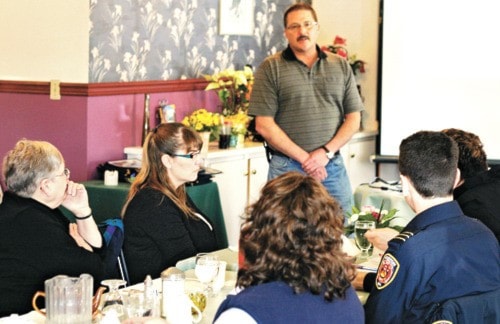Huckleberry Mine will see more than $100 million in spending this year as workers prepare to dig deep and extend the mine’s life to 2021.
Speaking Thursday to the Houston Chamber of Commerce, Vice General Manager Bryan Deagle said Huckleberry’s 2012 budget will cover everything from a new tailings dam to major equipment and camp upgrades.
“It’s a huge investment by our ownership,” Deagle said Owners Imperial Metals and the Japan Group are banking on the long-term, he added, noting that this year’s $100-million capital plan exceeds the mine’s annual revenues.
Huckleberry’s extension plan got a green light in November, when a review committee chaired by the B.C. Ministry of Mines permitted the company to log some 70,000 cubic metres of timber and build a new tailings pond.
That timber contract went to loggers at Tahtsa Timber and to the Houston Forest Products sawmill, Deagle said.
Deagle said several earthworks companies have already bid on the contract to build a clay and rock dam for Huckleberry’s new tailings pond.
“We want to take time to make sure we do everything right,” he added, noting Huckleberry’s strong record on water management and the tough lessons learned from leaching at older projects like Equity Mine.
“I don’t think there was a great understanding in those years about ARD [acid rock drainage] and other issues,” he said. “Right off the bat, we committed to preventing issues like that.”
Aside from the new tailings pond and a few new camp buildings, Deagle said the mine site will basically stay the same size—about 4 km long and 2.5 km wide.
“The operation is not expanding. It’s extending its life,” said Deagle.
Essentially, Deagle said the plan is not to dig a new pits but to simply widen and deepen the “bowl” of an older pit to get at lower-grade ore that wasn’t profitable until copper, silver and gold prices hit their current highs.
All that extra work means Huckleberry will need new equipment and new workers.
“Our employee numbers are going to climb from about 230 to 290,” said Deagle.
Wendy Curtis, Huckleberry’s human resources manager, said the company has already received hundreds of job applications.
“One of our mandates is to hire local,” Curtis said. “And local for us is anywhere from Smithers to Burns Lake.”
About forty per cent of Huckleberry staff live in Smithers or Telkwa. Roughly a third live in Houston or Granisle.
Only seven per cent of Huckleberry staff currently live in Burns Lake, but Curtis said she’s received many applications from residents there after a January explosion and fire destroyed the town’s sawmill and main employer.
To house the new workers, who typically work four days on, four days off, Deagle said Huckleberry is building a new camp and renovating its old one.
“We’ve got a camp that’s been out there for 15 years,” he said. “It needs upgrades.”
One of those upgrades is a land-based Telus line that will boost internet access to Huckleberry and to the several logging and exploration companies working along that 120-km stretch south of Houston.
Until now, Deagle said Huckleberry workers have had to rely on satellite communications that have limited bandwidth.
While he looks forward to the upgraded camp, Deagle is clearly most excited by the new equipment that is now rolling up to Huckleberry. “It’s like going down to Sullivan’s and buying a new truck,” he said, laughing. “The guys are just drooling.”
Along with six new 150-ton Caterpillar trucks and a front-shovel excavator, Deagle said operators are already getting to use a new grater equipped with ergonomic seats and dual joysticks. New operators will train on-site using simulators provided by Finning.
All the new equipment is a big change for Huckleberry, which was immediately saddled by low copper prices and had to run a bare-bones setup when Deagle first started back in 1996.
“It’s been quite a ride for everybody at the mine,” he said.
